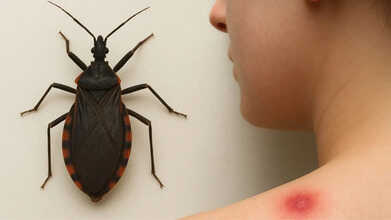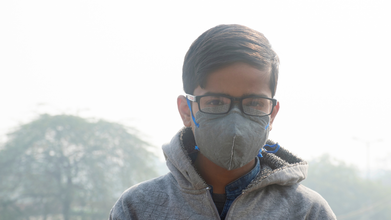- Health Conditions A-Z
- Health & Wellness
- Nutrition
- Fitness
- Health News
- Ayurveda
- Videos
- Medicine A-Z
- Parenting
‘Kissing Bug’ Endemic In US: What You Need To Know About Chagas Disease, Is it Contagious?

(Credit- Canva)
US Health officials have declared Chagas disease, a potentially deadly infection spread by the ‘kissing bugs’, an endemic. These bugs have been found in 32 states, and at least eight Americans have caught the disease from local transmission. This has led scientists to urge the CDC and the WHO to officially declare the illness as endemic in the U.S., which means it's a disease that is naturally present in the region. Experts believe that over 300,000 people in the U.S. may have Chagas disease, but very few of them know it.
What Is Chagas Disease?
According to UCLA Health, Chagas disease, a potentially life-threatening condition, is most commonly spread by the “kissing bug,” which gets its name because it tends to bite people on the face while they sleep. After biting, the bug defecates on the skin, leaving behind a parasite called T. cruzi. When the person scratches the itchy bite, they accidentally rub the parasite into the wound, and that's how it enters the bloodstream. Chagas disease can also be passed from a pregnant person to their baby, through organ transplants and blood transfusions, or by eating uncooked food that has been contaminated with the parasite.
Is Chagas Disease Contagious?
No, the Cleveland Clinic explains that this disease cannot spread from person to person. Many people with Chagas disease have no symptoms at all, which is why it's often called a "silent disease." In the early stage, which lasts about two months, some people might experience a swollen eyelid, fever, or body aches, but these symptoms are easily mistaken for other common illnesses.
Also Read: RFK Jr., at vaccine hearings, claims ‘We Were Lied To About Everything Around COVID.’
Over a person’s lifetime, about 20% of those infected will develop serious, long-term problems, most often affecting the heart. Chagas disease can slowly damage the heart, leading to an enlarged heart, heart failure, or even a heart attack. It can also cause digestive problems, like an enlarged colon.
How Big Are Kissing Bugs?
According to Texas A&M University, Kissing bugs are nocturnal insects that feed on blood. They are typically 1/2 to 1 inch long. Throughout their two-year lifespan, they bite people, dogs, and other animals multiple times to feed. Bites usually go unnoticed and do not attach like ticks.
What Are Signs And Symptoms of Chagas Disease?
According to the World Health Organization (WHO), Chagas disease happens in two main stages. For most people, the first stage goes unnoticed, but it can lead to very serious problems later on.
The First Stage
This early phase lasts for about two months after a person is infected. Most people have no symptoms at all, or they experience mild, general symptoms that could be caused by anything else, such as a fever, headache, muscle pain, or swelling. In rare cases, a person might see a specific sign, like a skin sore where they were bitten, or a purple swelling of one eyelid.
The Second Stage
The second stage of the disease can last for a person's entire life. During this time, the parasites hide mainly in the heart and muscles of the digestive system. About 10 to 30 years after being infected, up to a third of people will develop serious heart problems, and up to 1 in 10 will have digestive issues, such as an enlarged food pipe or colon. Over time, this can lead to an irregular heartbeat, slow heart failure, and in some cases, sudden death.
How To Treat Chagas Disease?
Anti-parasite medications are only effective at treating Chagas disease during its very early stage. Once the disease has been in the body for a while, there is no cure, though symptoms of heart failure can be managed with medication or even a heart transplant.
Doctors recommend that anyone who is from or has traveled to Latin America and begins to experience heart problems should be tested for Chagas disease. It's also worth noting that the U.S. blood supply has been tested for Chagas since 2007.
How Can We Prevent Chagas Disease?
WHO explains that because Chagas disease is carried by "kissing bugs" and is so widespread among wild animals throughout the Americas, it's not possible to completely wipe it out. Instead, public health efforts are focused on stopping the disease from spreading to humans, making sure infected people get diagnosed early, and providing them with lifelong medical care. To prevent the spread of Chagas disease, health organizations recommend a few key approaches:
Controlling the bugs
This is considered the most effective way to prevent the disease. It includes spraying homes and surrounding areas with bug-killing chemicals and making sure houses are built and kept clean to prevent the insects from living in cracks in the walls.
Personal protection
People can protect themselves with personal measures like using bed nets and practicing good hygiene when handling food.
Screening donors
Screening blood donors is necessary to prevent the disease from spreading through blood transfusions and organ transplants.
Checking newborns
It is also important to test newborns and other children of infected mothers, as the disease can be passed during pregnancy.
Health Emergency Looms As Delhi Forms Expert Panel To Fight Air Pollution

Credits: iStock
Coughs. Sneezing. Wheezing. All of this can be heard everywhere, with many people taking sick leaves, and coming back to office still with health complains. This is what is happening in Delhi as the national capital remains in the 'very poor' category for its Monday morning Air Quality Index (AQI). The average AQI of the city stood at 318 on 7am, as per the Central Pollution Control Board (CPCB). The thick layer of smog has engulfed the city and there has been no improvement to get rid of the toxic air. Visibility too has been reduced in several areas, including Anand Vihar, India Gate, Dwarka, and ITO.
Amid the continuously worsening air condition in Delhi, the government has now formed an 'expert group' to combat air pollution as health crisis rise.
The panel will study how pollution builds up from human activity as well as natural causes and will recommend technology upgrades, policy reforms, and sector specific interventions that can be put into action.
Who Will Lead the Expert Panel
The group will be chaired by retired IAS officer and former Union Environment Secretary Leena Nandan. Other members include former CPCB member secretary Dr JS Kamyotra, IIT Delhi professor emeritus Mukesh Khare, IIT Kanpur professor emeritus Mukesh Sharma, and Dr Suneel Pandey, director of Circular Economy and Waste Management at TERI. Representatives from CAQM, the IMD, APAG, PHDCCI and senior officials from the Delhi government are also part of the group. The Secretary of Environment and Forest is a member, and the DPCC chairman will serve as member secretary.
What the Group Will Do
This expert panel will act as a high level advisory body, offering clear, actionable guidance that can shape both emergency responses and long term reforms. It will track the progress of current pollution control programs, study global best practices, and flag where corrections are needed. The group will meet every month, either in person or virtually, and will receive administrative support from the Delhi Pollution Control Committee. The initial tenure is six months, with the option to extend if required.
Government Planning and Oversight
Chief Minister Rekha Gupta has approved the expert group, along with a separate High Level Implementation Committee chaired by the Chief Secretary. While the expert group will guide policy and strategy, the implementation committee is responsible for enforcing directives, coordinating across departments, and ensuring timely action. Delhi BJP leader Manjinder Singh Sirsa has welcomed the move and said that combined efforts from the government and citizens can make a meaningful difference.
Delhi’s Pollution Levels Are Rising Fast
A new analysis by the Centre for Research on Energy and Clean Air (CREA) highlights the scale of the crisis. Delhi’s air pollution almost doubled in November, with average PM2.5 levels touching 215 micrograms per cubic meter. The city recorded 23 days of very poor air, six severe days, and only one poor day. Although stubble burning played a smaller role this year, contributing an average of 7 percent, the pollution remained dangerously high.
Across India, pollution trends were equally worrying. Nine of the ten most polluted cities saw higher pollution levels than last year. Ghaziabad was the worst affected, with PM2.5 levels at 224 micrograms per cubic meter.
According to CREA analyst Manoj Kumar, declining stubble burning shows some progress, but major year round sources such as transport, industry, power plants, and other combustion activities continue to drive the crisis. Without strong emission cuts in these sectors, pollution levels will keep breaching national standards.
Doctors Warn of a Deepening Health Emergency
In an interview with ANI, doctors from AIIMS described Delhi’s air quality as a medical emergency. Prof Dr Anant Mohan and Dr Saurabh Mittal from the Department of Pulmonary, Critical Care, and Sleep Medicine said the current situation is now putting vulnerable groups at serious risk, including pregnant women, unborn babies, newborns, and adults with heart or neurological conditions.
Dr Mohan warned that the impacts may be felt for generations. Since the particles are extremely small, they can pass from a pregnant woman to the fetus and interfere with growth. Babies exposed to such conditions in the womb are more likely to be underweight and may have weaker lungs as they grow. Some complications might show up only later in life.
Dr Mittal added that the effects of toxic air go far beyond respiratory illness. Prolonged exposure is increasing cases of breathlessness, lung inflammation, asthma attacks, and chronic conditions like COPD. Fine particulate matter is also entering the bloodstream, raising the risk of heart attacks and strokes.
The growing health concerns underline the need for immediate and coordinated action, making the work of the newly formed expert group even more urgent.
How To Read Delhi's AQI?
0-50: 'good'
51-100: 'satisfactory'
101-200: 'moderate'
201-300: 'poor'
301-400: 'very poor'
401-500: 'severe'
Unique Symptoms Of H3N2 Flu Strain In UK And How Long Infection Now Last

Credits: iStock
It is that time of the year when cough and colds are at its peak and everyone you know if affected by it. However, the health experts have warned that this winter could be worst, worse than the previous one. Why? Because this winter may have the most severe flu outbreaks in decades. The worst part? It is already wreaking havoc on the NHS.
The flu strain being talked about here is the H3N2 strain, what has also been named as the "unpleasant" by health experts. The experts have warned that NHS could face a "tidal wave" of illness ahead of Christmas. A per the reports, hospital admission rates for flu has already gone up to 56 per cent, as compared to the same week last year. As per the health experts, wearing a mask outside is must, especially if they feel unwell, and have encourages those who are eligible to get their vaccination.
What Is the H3N2 Strain?
H3N2 is one of the two main influenza strains currently in circulation. Also referred to as subclade K, it is the most prevalent flu strain in England right now, according to the UK Health Security Agency (UKHSA).
What Are The Doctors Saying?
The Independent spoke to Dr Giuseppe Aragona, GP and a medical adviser for Prescription Doctor, about this new strain and the ways to prevent sickness.
Dr Aragona explained that the letters and numbers used to classify flu strains come from the virus’s surface proteins called haemagglutinin, represented by H, and neuraminidase, represented by N.
He said that this specific combination can sometimes lead to more serious illness, particularly in older adults and people with underlying health conditions.
He added that H3N2 changes frequently, which means the version circulating this year may differ from earlier years or from the strain included in the seasonal vaccine. This can leave people more vulnerable to infection.
What are the symptoms?
According to the UKHSA, flu symptoms tend to appear suddenly. Extreme tiredness is common and this often helps distinguish flu from a cold, which develops more gradually.
The symptoms linked to H3N2 have been similar to typical seasonal flu. These may include fever, cough, a runny nose, body aches, vomiting or diarrhea.
People at higher risk of complications include children under five, especially those under two, adults over 65, pregnant women and individuals with chronic medical conditions such as asthma, diabetes, heart disease, weakened immunity or neurological illnesses.
If someone develops flu symptoms after close contact with pigs, doctors advise informing a healthcare provider immediately and mentioning that exposure.
How high are flu rates right now?
NHS England reported that an average of 1,717 patients a day were admitted to hospital with flu last week. This is a 56 per cent rise from the same period last year.
- The rates are seven times higher than in 2023, when hospitals saw an average of 243 flu patients a day.
- This spike follows Australia’s biggest flu season on record, which often predicts how the UK will fare.
Why is H3N2 hitting harder this winter?
Dr Aragona said several factors are contributing to a more challenging flu season. The season has begun earlier than usual, giving the virus more opportunity to spread.
He added that the strain has evolved from last year’s version, so immunity from previous infections and even the vaccine may offer less protection.
He also pointed out that fewer people have been exposed to flu in recent years, especially children. This means a larger portion of the population is susceptible. Cold weather, indoor gatherings and normal social habits are also helping the virus spread more easily.
Experts have already noted that this strain picked up seven new mutations over the summer, making it quite different from previous versions in the current vaccine.
With winter underway, the UK is preparing for a rise in flu related deaths. NHS leaders have issued a strong appeal for people to get vaccinated. Last winter saw around 8,000 deaths linked to flu. This was higher than the previous year’s 3,500 deaths but lower than the 16,000 recorded in the 2022 to 2023 season.
How can you protect yourself?
Dr Aragona said getting the flu vaccine is the most important step, especially for people who are older, pregnant, very young or managing long term health conditions.
He said the vaccine does not prevent every infection but it greatly reduces the chances of severe illness and hospitalisation.
Good hand hygiene, covering your mouth and nose when coughing or sneezing, avoiding close contact with sick individuals and keeping indoor spaces well ventilated can also help.
New data from the UKHSA shows the 2025 to 2026 vaccine is currently 70 to 75 per cent effective at preventing hospital visits in children aged two to seventeen, and 30 to 40 per cent effective in adults.
Dr Jamie Lopez Bernal of the UKHSA said the early results offer reassuring evidence that this year’s vaccine provides meaningful protection. He encouraged everyone eligible to get vaccinated as soon as possible.
Dr Thomas Waite, deputy chief medical officer, said flu can be unpleasant for many people and dangerous for some. He emphasised that vaccination is the best defence. He said the season has started early and that those eligible should get their vaccine now.
Last year’s flu vaccine significantly reduced the number of severe cases, cutting hospitalisation by nearly 40 per cent in people over 65 and by 75 per cent in children aged two to seventeen.
How worried should we be about H3N2?
Dr Aragona said that while flu can be uncomfortable, most healthy adults and children recover without complications. He advised against panic but highlighted that older people, those with chronic illnesses and other vulnerable groups could face more serious illness this season.
He said the key is staying alert, getting vaccinated, taking sensible precautions and seeking medical help early if symptoms worsen. With these steps, he said the risks can be managed, even in a year with higher flu activity.
One Dead, 21 Poisoned: California Sounds Alarm Over Toxic Death Cap Mushrooms; Here's How To Identify Them

Credits: iStock
Officials in California have now urged people to not forage for wild mushrooms after a rise in poisoning cases that caused at least one death. The California Poison Control System was able to identify at least 21 cases of poisoning in northern California. This has resulted from death cap mushrooms, confirmed the state's public health department.
How Bad Is The Mushroom Poisoning?
The poisoning has resulted in severe liver damage in people and have not spared even children. It has killed at least one of the patients who may have needed a liver transplant, confirmed the health department.
The problem is that death cap mushrooms could be easily mistaken for safe, edible mushrooms because of its similar taste, smell, and appearance.
What Do Health Officials Say?
Health officials have confirmed that the recent cases occurred between mid November and early December, a period marked by heavy rainfall in the region. The wet weather creates perfect conditions for the toxic death cap mushroom to thrive, especially around oaks and other hardwoods, including pine trees, according to the California Department of Public Health (CDPH).
While most cases have been concentrated in Monterey and the San Francisco Bay Area, the CDPH cautioned that the danger extends across California.
“Death cap mushrooms contain toxins that can cause life threatening liver failure,” said Dr Erica Pan, CDPH Director and State Public Health Officer. “Because these mushrooms can be easily confused with edible varieties, we strongly urge the public to avoid foraging for wild mushrooms during this high risk season.”
The agency stressed that death caps are unsafe under any circumstances. Cooking, freezing, boiling or drying them does not remove their toxicity.
Consuming the mushroom can trigger symptoms such as nausea, vomiting, watery diarrhoea, abdominal pain and dehydration within six to 24 hours. Although the discomfort may briefly subside, serious or even fatal liver damage can develop up to eight days later.
“Only individuals with significant expertise in identifying wild mushrooms should eat those they have harvested themselves,” Dr Edward Moreno, Health Officer for Monterey County, said.
Ways To Identify Death cap Mushroom
Inspect the cap: look for a green or yellow tint on top of the mushroom's white cap. The caps of mature mushrooms also have 1 to 2 large cracks running across them. Death caps often have 1 or more patches of thin, white, vein-like tissue.
A flat cap with diameter 3 to 6 inches: mature death caps are widely and nearly flat on top. However, young death caps have an almost spherical, bowl-shaped cap.
Gills underneath cap: the death mushroom cap has thin white gills on the underside of the cap.
Smell: hold the mushroom about 3 inches away from nose and take a sniff. A death cap mushroom shall smell slightly like ammonia or other chemical household cleaners.
Touch: Tap the death cap mushroom lightly so you do not break it off. The caps of death cap mushroom are often sticky and could leave a small amount of adhesive residue.
Look for white spores left behind: place the mushroom cap on a piece of dark colored paper with gills facing downward. Let the mushroom sit in this position and next morning lift up the mushroom cap and look for white spore print on the sheet. A death cap mushroom will leave a white spore print.
© 2024 Bennett, Coleman & Company Limited

